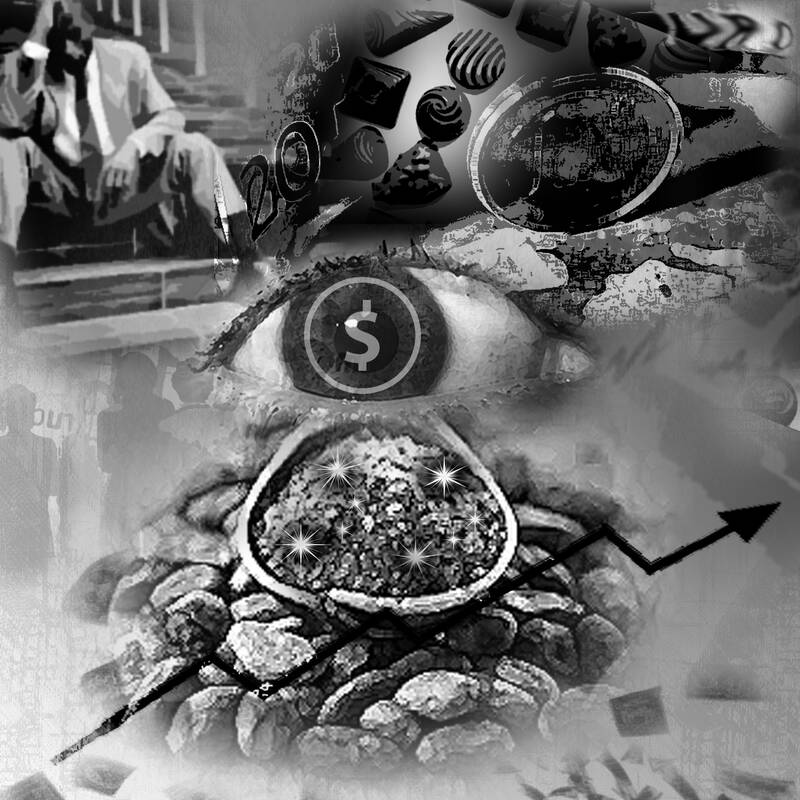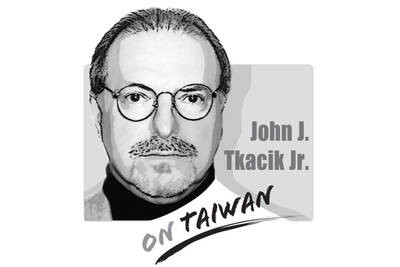In every sustained commodity price rally, there is a moment when fundamentals — supply, demand, inventories — no longer matter. The cost of the molecules, whether in the form of energy or foodstuffs or metals, stops being a price and becomes just a number. The market ceases to be orderly and becomes unruly.
It is clear that moment has arrived for cocoa.
Cocoa futures in New York on Tuesday surged above the previously unthinkable US$10,000 a tonne. In dollar terms, they surged more than US$1,000 over two days — equal to the trading range that in the past would have taken one year to witness.

Illustration: Kevin Hsu
First, a look at how it started. Initially, cocoa’s troubles were firmly rooted in fundamentals, triggered largely by a series of crop failures in west Africa, the region that typically produces about 75 percent of the world’s supply. There, a combination of aging trees, diseases and bad weather combined to create the largest shortfall seen in the cocoa market in more than six decades.
The upshot was a brutal price rally that took cocoa to US$6,000 a tonne by February from US$2,500 a year ago, surging above the 1977 record. Facing a massive deficit, the market was doing its work by sending prices high enough to curb consumption, and restore the supply-and-demand equilibrium.
Although in nominal terms cocoa prices are at a record level, in real terms — adjusted by inflation — prices remain below the peaks of the 1970s. The record high set back then is equal to about US$27,000 a tonne in today’s money.
However, since then prices have risen vertically, setting fresh highs almost daily. Granted, the cocoa deficit is so large — three consecutive years of shortfalls and potentially a fourth one coming — that sky-high prices are needed to curb consumption meaningfully, but the last few weeks of daily record highs have more to do with financial factors than fundamentals.
To understand what is happening one needs to look at the plumbing of the market — and who is bearish and who is bullish. Why are some traders still maintaining short positions — that is, bearish bets — in cocoa futures even though every fundamental has pointed toward higher prices for several months?
The reason is hedging. Cocoa traders holding a long position in the physical market — owning inventories of cocoa beans or semi-processed products such as cocoa liquor, butter and powder — typically offset that by taking the opposite position in the financial market. The hedge should work — in a rising market, like the current one, losses on the short positions are covered by gains on the value of the physical holdings, but as they wait for the financial contracts to mature — as long as several months — they need cash to meet margin calls on those losses on derivatives.
In a normal market, companies use cash reserves to meet those margin calls or borrow small amounts of money, but in a sustained bull run, like the one currently engulfing cocoa, the margin calls might overwhelm the capacity to pay of a company in otherwise sound financial health, forcing it to lift its hedges to avoid a cash crunch. In that scenario, the only option is to close out the short positions at whatever price the market demands. That is why I said that at times, prices are not prices — just numbers. The alternative is to default.
Disorderly markets can lead to trading firms struggling, and even collapsing. That is what happened in the European electricity and natural gas markets in 2022, forcing several European governments to offer taxpayer-funded credit lines to traders to meet margin calls. It also happened in the cotton market in 2008 and again in 2011, prompting the collapse of the historic trading house Paul Reinhart.
In the cocoa market, I am hearing chatter about a cash crunch as margin calls balloon. As with cotton, cocoa is a market dominated by a few large players and a handful of small-sized trading houses that might struggle to secure credit in a pinch. Regulators should pay close attention to the market with a view to helping anyone in difficulty before the issue metastasizes.
There is a second problem. Currently, some cocoa traders face a mismatch between their physical long positions and their short financial positions. In industry parlance, they are overhedged because they have sold futures worth more than they hold in actual products. The reason? The crop failure has reduced deliveries, with traders securing fewer beans and semi-processed products than they originally contracted for.
Cocoa processing plants in Ivory Cost and Ghana, for example, have stopped working due to lack of supply, failing to deliver products they have already sold. If delivered, some of those beans and products are being dispatched later than expected, so some traders have their financial hedges covering the wrong months. All those mismatches are forcing traders to buy back their hedges at inflated levels.
The magnitude of the margin calls and overhedging is clear in the rapid decline of the aggregate number of outstanding contracts on the New York and London cocoa futures market. The so-called open interest has fallen by 35 percent over the past three months — the largest drop in such a small timeframe in at least three decades — as traders buy back their positions. Ultimately, it is a self-sustaining problem — the higher cocoa prices rise, the bigger the margins calls and the scale of overhedging, and as some traders buy back their positions, they push prices up further, creating the same problem for others.
Once prices become untethered from fundamentals, a bull market is almost impossible to stop — until something breaks. Brace for the current surge in cocoa to have wider ramifications than inflating the cost of your Easter egg.
Javier Blas is a Bloomberg Opinion columnist covering energy and commodities. He is coauthor of The World for Sale: Money, Power and the Traders Who Barter the Earth’s Resources. This column does not necessarily reflect the opinion of the editorial board or Bloomberg LP and its owners.

On May 7, 1971, Henry Kissinger planned his first, ultra-secret mission to China and pondered whether it would be better to meet his Chinese interlocutors “in Pakistan where the Pakistanis would tape the meeting — or in China where the Chinese would do the taping.” After a flicker of thought, he decided to have the Chinese do all the tape recording, translating and transcribing. Fortuitously, historians have several thousand pages of verbatim texts of Dr. Kissinger’s negotiations with his Chinese counterparts. Paradoxically, behind the scenes, Chinese stenographers prepared verbatim English language typescripts faster than they could translate and type them
More than 30 years ago when I immigrated to the US, applied for citizenship and took the 100-question civics test, the one part of the naturalization process that left the deepest impression on me was one question on the N-400 form, which asked: “Have you ever been a member of, involved in or in any way associated with any communist or totalitarian party anywhere in the world?” Answering “yes” could lead to the rejection of your application. Some people might try their luck and lie, but if exposed, the consequences could be much worse — a person could be fined,
Xiaomi Corp founder Lei Jun (雷軍) on May 22 made a high-profile announcement, giving online viewers a sneak peek at the company’s first 3-nanometer mobile processor — the Xring O1 chip — and saying it is a breakthrough in China’s chip design history. Although Xiaomi might be capable of designing chips, it lacks the ability to manufacture them. No matter how beautifully planned the blueprints are, if they cannot be mass-produced, they are nothing more than drawings on paper. The truth is that China’s chipmaking efforts are still heavily reliant on the free world — particularly on Taiwan Semiconductor Manufacturing
Keelung Mayor George Hsieh (謝國樑) of the Chinese Nationalist Party (KMT) on Tuesday last week apologized over allegations that the former director of the city’s Civil Affairs Department had illegally accessed citizens’ data to assist the KMT in its campaign to recall Democratic Progressive Party (DPP) councilors. Given the public discontent with opposition lawmakers’ disruptive behavior in the legislature, passage of unconstitutional legislation and slashing of the central government’s budget, civic groups have launched a massive campaign to recall KMT lawmakers. The KMT has tried to fight back by initiating campaigns to recall DPP lawmakers, but the petition documents they